79th Light Anti-Aircraft Battery
| 79th Light Anti-Aircraft Battery (21 LAA Rgt 79 Bty RA) 'The Sparrows' | |
|---|---|
|
Royal Artillery Cap Badge and Anti-Aircraft Patch | |
| Active | 1939–1946 |
| Country |
|
| Allegiance | Allies |
| Branch | |
| Type |
|
| Role |
Anti-Aircraft Warfare, Field Artillery, Heavy Machine Gun Warfare |
| Size |
3 Troops, 12 Detachments, 250 men Timor
|
| Part of |
|
| Garrison/HQ | Walton-on-Thames |
| Motto(s) |
Ubique (Everywhere) Quo Fas Et Gloria Ducunt (Where Right And Glory Lead) |
| Colours | The guns are regarded as the regimental colours and are accorded the same compliments as the Standards, Guidons and Colours of the Cavalry and Infantry |
| March | British Grenadiers (Quick March) Scipio (Slow March) |
| Anniversaries | 23 February |
| Engagements | |
| Commanders | |
| Ceremonial chief | HM King George VI |
| Regiment Commander | Lt-Col Martin Saunders (21 LAA Regt) |
| Notable commanders | Major Jack Dempsey |
| Insignia | |
| (Top) The hat of The Sparrows - an Australian Slouch Hat, folded pungaree, and Royal Artillery Cap Badge. (Below) Light Anti-Aircraft patch. |
 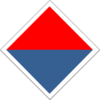 |
 |
"The British Grenadiers"
"The British Grenadiers" performed by the United States Army Band Strings ensemble |
| Problems playing this file? See media help. | |
The 79th Light Anti-Aircraft Battery, also known as "The Sparrows", was a Royal Artillery unit of the British Army that fought with distinction in the Battle of Britain, the Battle of Java, and the Battle of Timor.
History
Formation
The 79th Light Anti-Aircraft (Ack-Ack) Battery was an independent Territorial Army unit (‘the weekend warriors’) of the Royal Artillery of the British Army.
Formed in the winter of 1939, they were based initially at Walton-on-Thames to defend key installations including water reservoirs supplying London. Originally containing mostly London volunteers, the battery became a full-time unit at the start of September 1939 when war with Germany became inescapable. As with all Territorial Army units, the battery was absorbed into the regular army by the end of that month. Together with three other similar batteries they became part of the 36th Light Ack-Ack Regiment.
Battle of Britain
During the first two years of the war the unit was employed on anti-aircraft protection duties in the Luftwaffe’s Blitzes of London. The unit saw action during the Battle of Britain where it served with distinction defending the Hawker Aviation factory at Langley, Churchill’s country home at Ditchley and the oil refinery north of Bristol. Later, they were used in the protection of airfields and key installations in Cornwall and the Scilly Isles.
Formation of the 21 Light Anti-Aircraft Regiment
During the months the battery converted to using Bofors 40 millimetre automatic anti-aircraft artillery the battery was preparing to become a mobile battery. Conscripted 19-year-old cockney drivers were being trained in Blackpool. Replacement gunners were sourced from the 79th Light Anti-Aircraft Regiment trained at Hadrian's Camp in Carlisle. In November 1941 the men were all issued embarkation leave.
The battery was then formed with other batteries, including the 48th and 69th LAA batteries, into the 21st Light Anti Aircraft Regiment Royal Artillery for service overseas. The battery received some cursory training in mobile warfare during ‘Exercise Bumper’ and were now issued with desert kit and their equipment was painted in desert camouflage ready for overseas deployment in mid-November.
"Scuttlebutt"
At this stage of the war, the European theatre had expanded to the Middle East and North Africa and large convoys of reinforcements were being sent to Egypt via the long route around the South African cape and the Suez Canal. Other reinforcements were also being dispatched to India and Singapore.
The scuttlebutt amongst the 79th gunners was that they were being sent to Iraq to protect the Basra railhead. The new commanding officer of the 21 LAA Regt, Lt-Col Martin Saunders, was called to the War Office in the third week of November to be given instructions on the regiment’s destination and operational tasks. It was to be a most secret operation known only to a few. He, alone amongst the regiment, knew they were to be a part of a small advanced force for a landing in French Algeria and then a subsequent 500-mile (800 km) dash to capture the airfields at Tunis and Bizerta.
Deployment
The battery gunners left Gourock on the Warwick Castle at 8am on 7 December 1941. A small team from the 79th accompanied their equipment on the SS Malancha, which sailed independently from Liverpool on the same day as the Japanese launched their attacks on Malaya and Pearl Harbour.
Whilst at sea, the planners at the War Office decided to reschedule the operation which had been one of Winston Churchill’s pet projects, but without letting him know. The Operation would eventually take place a year later as “Operation Torch”.
The small convoy which had been embedded in a much larger troop convoy WS(14) for their voyage to Gibraltar – which was to be the staging post for the invasion of Algiers – did not detach on 11 December as planned but stayed with main convoy en route to South Africa. The ‘Force’ received no instructions about what would be their new destination and mission.
In Cape Town, they were to learn that Britain was now at war with Japan and their new assignment was to defend Singapore. Singapore was under attack before they arrived and they were redeployed to Batavia on the jungle covered island of Java on 3 February 1942. Their ship was attacked as it arrived in port.
In Batavia the 79th LAA Battery was split in two. Troop B was sent to defend the airfield of Malang while Troops A and C boarded the Ban Hong Leong on 9 February to defend Penfui airfield in Dutch Timor – the closest airfield to Australia.
Timor
After their ship was chased and attacked by two Japanese submarines, the ship was attacked by Japanese bombers as they arrived at Koepang port on 16 February.
In Timor, the battery of 189 personnel joined Sparrow Force – a contingent of 1400 Australian troops, – under the command of Australian Lt. Colonel William Leggatt.
To cope with jungle conditions (and the fear that their tall white pith helmets would attract sniper fire), the 79th Battery were issued with the Australian Akubra slouch hat, which they wore with the Royal Artillery cap badge. They are the only non-Australian troops to ever be issued with Australia’s traditional hat.
The 79th (British) LAA Battery were the only anti-aircraft artillery on Timor. C Troop defended the Penfui Aerodrome while two detachments of A Troop each defended the coastal guns at Klapalima and Force Headquarters at Force Hill.
The battery certainly proved an important part of Sparrow Force. In Leggatt’s log he praised its actions:
- “This unit showed its excellent discipline and training during the four days of action. Their guns registered eighteen hits upon enemy aircraft and reported 14 aircraft destroyed, including one four-engined troop carrier, and a twin-engine flying boat. Dive bombing did not deter them in the least, only ammunition shortages prevented them from engaging all enemy aircraft presented.”
According to Captain Fred East’s Intelligence Report,[1] the 79th LAA Bty claimed to have shot down:
- 12 Mitsubishi G4M "Betty" bombers,
- 2 Mitsubishi Ki-57 "Topsy" troop carriers,
- 1 aircraft that resembled a Junkers Ju 88 (possibly a Kawasaki Ki-48),
- 1 aircraft that resembled a Douglas DC-3 (possibly the Showa/Nakajima L2D but most likely the Mitsubishi Ki-57), and
- 1 “naval bi-plane flying boat which was a persistent dive-bomber” (possibly the Mitsubishi F1M.)
They also claimed to have hit 18 bombers and fighters. "Some bombers had similar turret and fuselage to [the Blenheim bomber ]. All bombers were twin-[engined]."
Japanese Captain Fukada of the Kambe Company Nishiyama “Ace” Battalion stated “that about 20 of their planes had not returned.” Natives claimed to have seen two crashed Japanese transport planes in the bush with about 28 bodies in each.
The 79th were potent against invading ground forces. The exploding Bofors shells amongst the coconut palms killed many advancing infantry. As a result of Sparrow Force actions, Japan's most successful and elite special force, the 3rd Yokosuka Special Naval Landing Force – which fought in China, Hong Kong, and Ambon – was decimated.
Only one casualty, Gunner Fred Watkins, died in combat. Three died on Timor from battle wounds. One member of the battery, Fred Berry, attempted to escape by boat to Australia while another, Harry Martin, was captured and executed while trying to pass important intelligence to the 2/2nd Independent Company in East Timor.
For a detailed description of the Battle of Timor see Battle of Timor (1942–43).
| 79 LAA Bty Casualties | |||
|---|---|---|---|
| |||
| Casualties and losses | |||
|
Total Casualties
|
66
| ||
Capture
After capitulation on 23 February 1942 the battery was held at Usapa Besar POW camp until 23 September 1942. They were then herded into the hold of an old Chinese freighter, the hellship Dainichi Maru, with the rest of Sparrow Force and transported to Surabaya via Dili coming under attack from Royal Australian Air Force bombers and Royal Navy and Dutch submarines. From there they travelled by train to Batavia and marched 11 miles (18 km) to Makasuru where they were separated from the Australians and Dutch to join the R.A.F. POWs in #5 camp. There they rejoined their comrades from B Troop.
On 15 October the Battery was broken up and sent to different parts of South East Asia. Some were held on Java while on 18 October the rest of the battery boarded the notorious Singapore Maru and Oshida Maru freighters to endure a one-week voyage to Singapore.[2]
At Singapore the battery were marched 15 miles (24 km) to Changi Barracks where they would be medically examined and assessed for labour camps throughout South East Asia. Some were sent to work on the Siam-Burma ‘Death’ Railway, sent to build the Sumatra Railway, sent to work in labour camps all over Japan, or remain in Singapore at the notorious Changi Prison.[3]
Those who travelled to Japan to work in labour camps endured 46 days on the hellship Dainichi Maru and Tofuku Maru. Most casualties were aboard these hellships – from disease shortly after disembarking at Moji.
In Japan, the 79th gunners on the Tofuku Maru travelled by train to Hiraoka where they were held at the Tokyo #2 Detached (Mitsushima) POW Camp. There, they worked to build the Hiraoka Dam. In April 1944, most of the gunners were sent by train to the Tokyo #16 (Showa Denko) POW Camp in Kanose to stoke furnaces in the carbide factory. The gunners who disembarked the Dainichi Maru joined the Fukuoka #1 POW Camp. This group would be later split and relocated to camps in Moji, Kumamoto, Orio, Ube, Omine and Bibai.
Many died from disease or accidents in labour camps on the Siam-Burma ‘Death’ Railway, in Sumatra, Japan, Java, Borneo, and Changi Prison. Later in the war, several died when their hellships were sunk by United States Navy submarine en route to Japan from Singapore.
Aftermath
After the war ended, Bombardier A.H. 'Jock' Compton fell through the bomb bay doors of a converted B-24 Liberator bomber transporting liberated POWs from Okinawa to Manila. 30 other bombers were brought down by a typhoon on the same day on the same route killing almost a thousand liberated prisoners of war.[4] To put this number in perspective, 1036 prisoners of war in Japan died during the war.
War Crimes Trials
Several members of the battery were victims of war crimes. In what would be the first war crimes trial after the war, at Yokohama, Tatsuo Tsuchiya was found guilty of mistreatment of several battery members which resulted in deaths at Mitsushima POW Camp at Hiraoka. Several other guards at that camp would also be executed or imprisoned for their roles in the deaths and ill treatment of battery members. In other Yokohama War Crimes Trials, several battery members testified against Japanese guards for the ill-treatment of fellow battery members at Kanose and Fukuoka Branch camps.
In Darwin, Kempeitai Lieutenant Colonel Yujiro Yutani was tried, found guilty, and executed for killing Gunner Harry Martin.
In Singapore, Otsu Shiro was found guilty of ill-treatment of Allied POWs resulting in the death of twenty-seven and physical suffering of many others on the Tofuku Maru.[5] Other Japanese and Korean guards were tried for their roles at POW Camps on Java, Siam-Burma ‘Death’ Railway, Sumatra, and the Sandakan Death Marches on Borneo.
Disbandment
Up until the end of the war, the unit was also known as:
- 21 LAA Rgt 79 Bty RA
- 79th (Timor) LAA Bty RA
- 79th (British) LAA Bty
- B Troop 79th LAA Bty RA
After the war the 79th LAA Battery was disbanded and it would thereafter be recorded as the 79th (Timor) LAA Battery – the ‘Sparrows.’
Decorations
Second Lieutenant A.H. Samuelson was awarded the Military Cross.[6][7] In his citation, it states:
- On 22 February 1942, at 0730 hours 'A' Troop 79 LAA Battery, R.A., under the command of 2/Lieut A.H. SAMUELSON R.A., were attacked by enemy parachutists from an ambush some 800 yards EAST of village of BABOE in TIMOR. The enemy, who opened a heavy fire using Mortars and Automatics, were posted in trees and thick undergrowth. Two platoons AIF counter attacked.
- 2/Lieut SAMUELSON rallied personnel and displayed considerable coolness directing offensive action while under fire. At one time, the LAA guns were completely encircled and continuously sniped from some 100 yards distance until the two AIF platoons counter attacked.
- Casualties 1 killed and 6 wounded.
Each member of The Sparrows earned the following medals:
| | | | |
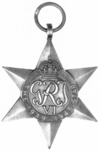 | 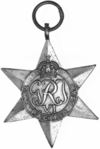 | 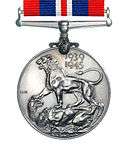 | |
| 1939-1945 Star | Pacific Star (Burma clasp) | Defence Medal | War Medal |
Commanders
| Rank | Name | Command |
|---|---|---|
| Major. | Dempsey, John Patrick Heyward | Battery Commander |
| Capt. | Craig, William Marshal | 2nd in Command |
| 2nd Lt. | Samuelson, A.H. | A Troop Commander |
| 2nd Lt. | Bell, Robert Peter Mangin(Peter) | A Troop 2nd in Command (& Transport) |
| 2nd Lt. | Scott, Charles Walter | C Troop Commander |
| 2nd Lt. | Baillie, Andrew | C Troop 2nd in Command |
| WOII | White, Reginald (Ron/Abdul) | Battery Sergeant Major |
| BQMS | Collett, William Joseph (Bill) | Battery Quartermaster Sergeant |
| Sgt. | Birkhead, Richard Walter (Dickie) | Battery Sergeant Fitter |
| S/Sgt | Lucas, Henry | Transport Sergeant |
| Sgt. | Lucas, Alfred | Transport Sergeant |
| L/Sgt. | Jones, Alfred Aubrey (Bob) | A1 Detachment |
| Sgt. | Weston, Ronald James | A2 Detachment |
| Sgt. | Brockway, Roy Frederick | A3 Detachment |
| Sgt. | Storey, James Matthew (Paddy) | A4 Detachment |
| Sgt. | Kember, Denis George | C1 Detachment |
| Sgt. | Brown, Gibson Harrison | C2 Detachment |
| Sgt. | Evans, Henry | C3 Detachment |
| Sgt. | King, George Herbert | C4 Detachment |
Equipment
Primary weaponry
 | 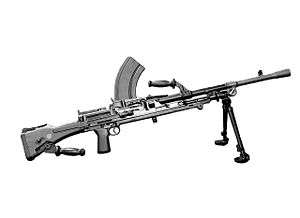 | |
| 'Bofors' Gun | Lewis gun | Bren Gun |
Timor
- 8 x 'Bofors' 40 millimetre Quick-Firing Automatic Anti-Aircraft Artillery
- 16 x Lewis guns
- 12 x Mark 2 Bren Guns
Malang
- 4 x Bofors 40 millimetre automatic anti-aircraft artillery
- 8 x Lewis guns
- 6 x Mark 2 Bren Guns
Secondary weaponry
_-_UK_-_cal_303_British_-_Arm%C3%A9museum.jpg) | | |
| No.1 Mk.III* Lee–Enfield rifle | No. 69 grenade | .38 Enfield revolver |
- No.1 Mk.III* Lee–Enfield rifles
- No. 69 grenades
- .38 Enfield revolvers (used by officers)
Primary transport
Timor
- 8 x Chevrolet 5 tonne trucks/tractors
Malang
- 4 x Chevrolet 5 tonne trucks/tractors
Secondary transport
Timor
- 2 x Chevrolet 1.5 tonne utility trucks
- 4 x motorcycles with sidecars
Malang
- 1 x Chevrolet 1.5 tonne utility trucks
- 2 x motorcycles with sidecars
Gallery
-

Founding members,

79 LAA Bty RA,
Walton on Thames, 1939. -

Transport gunners,

79 LAA Bty RA,
Blackpool, 1941. -

C Troop,

79 LAA Bty RA,
Scilly, 1941.
Roll of honour
|
Full Name | Serial # | Last POW Camp | Death | Cause |
|---|---|---|---|---|---|
| Gnr. | Letham, James Dempster | 1826529 | Fukuoka | 1944/06/24 | Drowned (Tamahoko Maru) |
| Gnr. | Adams, David Francis | 1614691 | Fukuoka 6B (Orio) | 1944/12/28 | Illness |
| L/Bdr. | Angel, John Lindsay | 1552212 | Fukuoka #1 (Kumamoto) | 1945/08/02 | Illness |
| Gnr. | Bartlett, William Nathaniel | 1826535 | Sumatra | 1945/02/07 | Illness |
| Gnr. | Bennett, Albert Sydney George | 1653987 | Burma-Siam Railway | 1943/09/26 | Illness |
| Gnr. | Buchan, John Ford | 1693996 | Tokyo #16B (Kanose) | 1945/03/11 | Accident |
| Gnr. | Burnett, John Reginald | 1548346 | Burma-Siam Railway | 1943/06/25 | Illness |
| L/Bdr. | Burton, Edmund David | 1548410 | Usapa Besar, Timor | 1942/06/23 | Illness |
| Gnr. | Casey, Albert Edward | 1654002 | Tokyo #2D (Mitsushima) | 1942/12/09 | Illness |
| Gnr. | Chandler, Harold | 1735808 | Tokyo #2D (Mitsushima) | 1943/02/24 | Illness |
| Bdr. | Charman, Wilfred Harry | 1616543 | Tokyo #2D (Mitsushima) | 1943/04/06 | Illness |
| Gnr. | Cockaday, William Bob | 1735528 | Fukuoka #1 (Kumamoto) | 1942/12/18 | Illness |
| Gnr. | Coe, Albert James | 1654010 | Tokyo #2D (Mitsushima) | 1943/03/04 | Illness |
| Bdr. | Compton, Arthur Frank | 1552186 | Tokyo #16B (Kanose) | 1945/09/10 | Air Accident |
| Gnr. | Cook, John Harold | 1654011 | Sumatra | 1943/11/29 | Illness |
| Gnr. | Crowdell, Oliver | 1511317 | Tokyo #16B (Kanose) | 1945/03/11 | Accident |
| Gnr. | Cunliffe, Calvert | 1809144 | Fukuoka #4 (Moji) | 1945/02/24 | Illness |
| Gnr. | Cunningham, Walter Pendreich | 1826556 | Burma-Siam Railway | 1943/08/10 | Illness |
| Sgt. | Evans, Henry | 1545870 | Usapa Besar, Timor | 1942/07/02 | Wounds |
| Gnr. | Foster, John | 1826509 | Tokyo #16B (Kanose) | 1943/03/28 | Accident |
| L/Bdr. | Gallucci, Adolphus | 1654030 | Java | 1943/01/23 | Illness |
| Gnr. | Goodworth, Harold | 1781571 | Fukuoka #1 (Kumamoto) | 1943/02/24 | Illness |
| Gnr. | Hills, Nelson John | 1653876 | Fukuoka #4 (Moji) | 1945/03/14 | Illness |
| Gnr. | Hocking, Joseph | 1548784 | Fukuoka #1 (Kumamoto) | 1942/12/14 | Illness |
| Gnr. | Hudson, Thomas Henry | 1809178 | Fukuoka #1 (Kumamoto) | 1943/01/17 | Illness |
| L/Bdr. | Jarvis, Denis Arthur Claud | 1556170 | Fukuoka #1 (Kumamoto) | 1945/03/12 | Illness |
| Sgt. | King, George Herbert | 1453589 | Tokyo #2D (Mitsushima) | 1943/08/17 | Illness |
| Gnr. | Mackie, Andrew | 1774706 | Tokyo #2D (Mitsushima) | 1942/12/06 | Illness |
| Gnr. | Mansell, Percy Stuart John | 1548785 | Changi | 1944/06/24 | Drowned (Tamahoko Maru) |
| Gnr. | Marshall, Gavin | 1826695 | Hiroshima 7B (Ube) | 1945/02/27 | Illness/Torture |
| Gnr. | Martin, Harold Laurence John | 6401712 | Usapa Besar, Timor | 1943/06/16 | Executed |
| Gnr. | McMahon, Henry | 1478716 | Java | 1944/09/18 | Illness |
| Gnr. | Medlar, Sydney Ernest | 1735606 | Fukuoka #1 (Kumamoto) | 1945/10/12 | Illness |
| Gnr. | Mills, Jack | 1456029 | Usapa Besar, Timor | 1942/03/10 | Wounds |
| Gnr. | Mitchell, Robert | 1826700 | Tokyo #2D (Mitsushima) | 1943/02/04 | Illness |
| Gnr. | Moore, Alfred John William | 1556169 | Changi | 1944/06/24 | Drowned (Tamahoko Maru) |
| Gnr. | Padbury, Charles | 1807286 | Changi | 1944/09/18 | Illness |
| L/Bdr. | Pascoe, Michael Bennett | 1555908 | Fukuoka #1 (Kumamoto) | 1943/03/04 | Illness |
| Gnr. | Rushton, William | 11060960 | Fukuoka #1 (Kumamoto) | 1943/02/19 | Illness |
| Gnr. | Sparke, John James | 1817355 | Burma-Siam Railway | 1943/06/29 | Illness |
| Gnr. | Todd, William | 1653920 | Sumatra | 1945/08/03 | Illness |
| L/Bdr. | Wallace, John | 1456027 | Usapa Besar, Timor | 1942/06/01 | Wounds |
| Gnr. | Watkins, Frederick James | 1818926 | 1942/02/22 | K.I.A. | |
| Gnr. | Wells, Gordon James | 1556203 | Changi | 1944/06/24 | Drowned (Tamahoko Maru) |
| Sgt. | Weston, Ronald James | 1452499 | Fukuoka #1 (Kumamoto) | 1942/12/09 | Illness |
| Gnr. | Wilkinson, James Leonard (Bluey) | 1807869 | Burma-Siam Railway | 1943/07/02 | Illness |
| Gnr. | Wright, Alfred Randolph | 1781386 | Fukuoka #1 (Kumamoto) | 1943/05/01 | Illness |
| Gnr. | Wright, James | 1735786 | Changi | 1944/06/24 | Drowned (Tamahoko Maru) |
| (Served at Malang, Java) | |||||
| Gnr. | Barkin, Jack | 1829651 | Palembang | 1945/08/03 | |
| Gnr. | Bold, Joseph | 1835288 | Singapore | 1944/08/27 | Drowned (Noto Maru) |
| L/Bdr. | Brown, Albert Joseph | 1597152 | Kuching | 1945/08/13 | Illness |
| L/Bdr. | Butt, Arthur Ashley | 1736369 | Hakodate (Bibai Coal Mine) | 1942/12/12 | Illness |
| Gnr. | Challoner, James Charles | 1552311 | Amboina | 1943/11/20 | Illness |
| Sgt. | Clarke, Ronald Dudley | 1555831 | Kuching | 1945/09/02 | Illness |
| Gnr. | Corderoy, Arthur Albert Henry | 1614718 | Malaysia | 1944/04/18 | Drowned (Hellship) |
| Bdr. | Emms, Douglas Charles | 1614637 | Ambon | 1943/11/29 | Drowned (Suez Maru) |
| Gnr. | Fitch, Leslie Ernest | 1807016 | Ambon | 1943/11/29 | Drowned (Suez Maru) |
| Gnr. | Foster, Charles Herbert | 1614639 | Ambon | 1943/11/29 | Drowned (Suez Maru) |
| Gnr. | Garrett, George Terence | 1807025 | Singapore | 1944/06/24 | Drowned (Tamahoko Maru) |
| Sgt. | Goff, Arthur John | 1458291 | Sarawak | 1945/07/26 | Illness |
| Gnr. | Head, John Edward | 1807157 | Sarawak | 1944/06/24 | Drowned (Tamahoko Maru) |
| Gnr. | McCulloch, William Henry | 1779808 | Singapore | 1945/02/16 | Drowned (Hellship) |
| W.O.II | Moth, John Bevington | 1456257 | 1942/12/10 | Illness | |
| Gnr. | Saban, Cyril Victor | 1807346 | Ambon | 1943/11/29 | Drowned (Suez Maru) |
| Gnr. | Skinner, John Robert Alexander | 1483416 | Java | 1944/09/18 | Drowned (Junyo Maru) |
| Gnr. | Smith, Kenneth | 1826738 | Ambon | 1943/11/29 | Drowned (Suez Maru) |
| Gnr | Stearn, Sidney | 1736274 | Ambon | 1943/11/29 | Drowned (Suez Maru) |
See also
Notes
- ↑ Paragraphs 48 & 49, Observations on Timor and Java During 1942 and afterwards: A.I.F. on Timor known as Sparrow Force. Captain Fred G. East VX64901 AHQ10 “Sparrow Force”, 29 October 1945, Melbourne.
- ↑ Rose 2002, p.76.
- ↑ Chater 2001.
- ↑ SCAP HQ & USAF investigation into Typhoon Ursula, September 1945. NARA RG
- ↑ http://socrates.berkeley.edu/~warcrime/Japan/singapore/Trials/Otsu.htm
- ↑ The London Gazette: (Supplement) no. 37585. p. 2613. 30 May 1946. Retrieved 6 January 2015.
- ↑ National Archives, Kew, United Kingdom.
References
- Chater, Leslie Hilton (2001). Behind the Fence: Life as a POW in Japan, 1942-1945: The Diaries of Les Chater. Canada: Vanwell. ISBN 1551250640.
- Rose, Bill (2002). You Shook My Hand. Kent: Barny Books.
External links
- COFEPOW: Timor Gunners from the 79th Battery 21 Light Anti-Aircraft Regiment
- Australian War Memorial, 2005, "Fighting in Timor 1942"
- Australian War Memorial, "Remembering Timor 1942"
- Australian Department of Veterans Affairs, 2005, "Fall of Timor"
- L. Klemen, 1999–2000, "The fightings on the Portuguese East Timor Island, 1942"
- L. Klemen, 1999–2000, "The East Timor Island, March 1942 – December 1942"
- L. Klemen, 1999–2000, "Dutch West Timor Island in 1942"
- The Australian 8th Division
- Digger History – Timor
